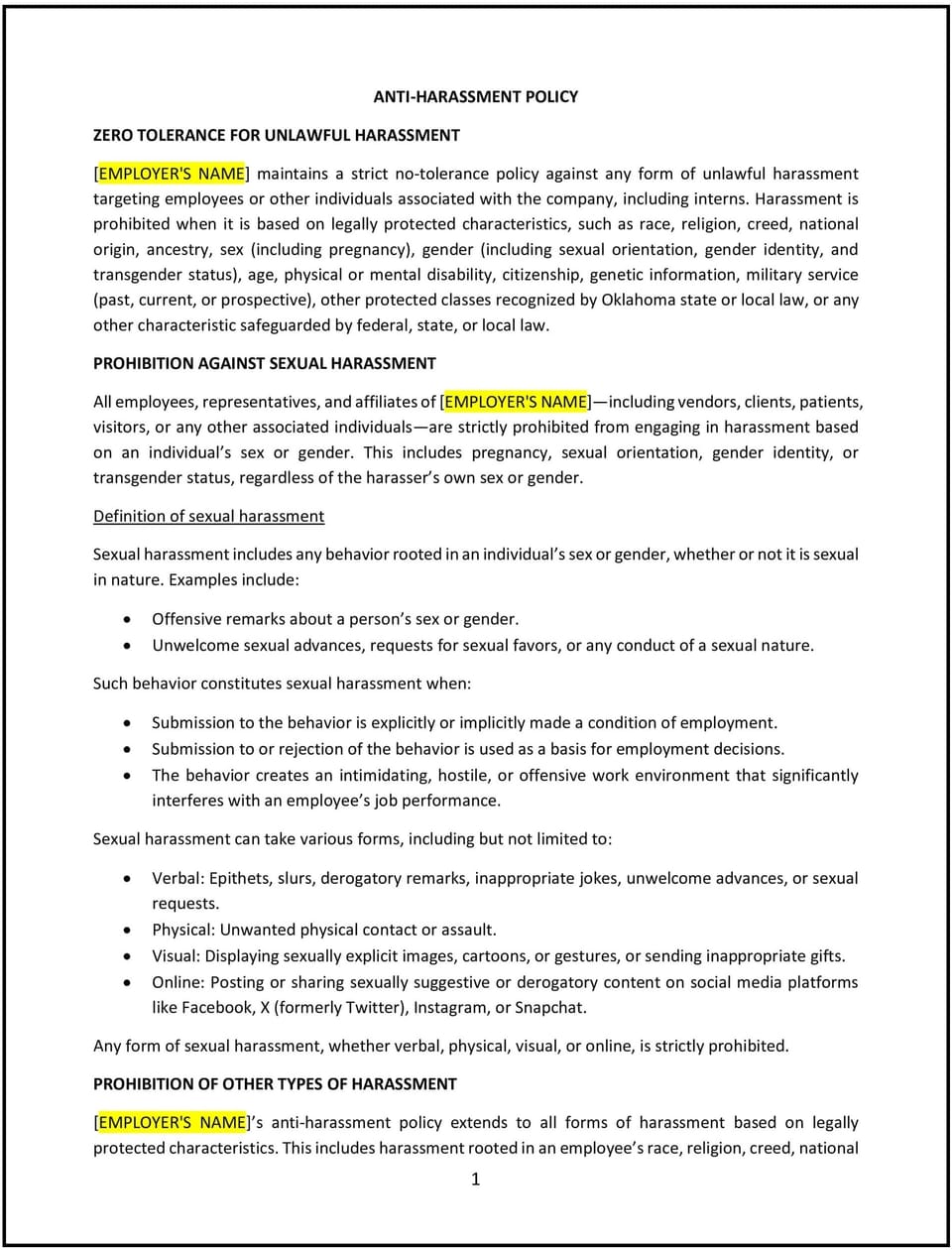Anti-harassment policy (Oklahoma): Free template

Anti-harassment policy (Oklahoma)
This anti-harassment policy is designed to help Oklahoma businesses create a respectful and inclusive work environment by preventing and addressing harassment. It outlines procedures for reporting, investigating, and resolving harassment complaints.
By adopting this policy, businesses can promote a positive workplace culture, reduce conflicts, and promote compliance with state and federal anti-harassment laws.
How to use this anti-harassment policy (Oklahoma)
- Define harassment: Clearly explain what constitutes harassment, including verbal, physical, and visual forms of harassment based on protected characteristics.
- Establish reporting procedures: Provide steps for employees to report harassment, including multiple reporting channels and anonymous options.
- Outline investigation processes: Describe how harassment complaints will be investigated, ensuring fairness, confidentiality, and promptness.
- Specify consequences: Define the disciplinary actions for confirmed harassment, such as warnings, suspension, or termination.
- Train employees and managers: Educate staff on recognizing and preventing harassment, and train managers on handling complaints effectively.
- Promote awareness: Regularly communicate the policy to employees and include it in the employee handbook.
- Review and update: Assess the policy annually to ensure it remains effective and aligned with evolving workplace dynamics and legal standards.
Benefits of using this anti-harassment policy (Oklahoma)
This policy offers several advantages for Oklahoma businesses:
- Promotes respect: Helps create a workplace culture free from harassment and discrimination.
- Reduces conflicts: Addresses harassment early, preventing escalation and fostering collaboration.
- Enhances compliance: Aligns with state and federal anti-harassment laws, such as Title VII of the Civil Rights Act.
- Mitigates risks: Reduces the likelihood of legal disputes or reputational damage related to harassment.
- Builds trust: Demonstrates a commitment to maintaining a safe and inclusive workplace.
Tips for using this anti-harassment policy (Oklahoma)
- Communicate clearly: Ensure all employees understand the policy and its importance.
- Train managers: Equip supervisors with the skills to handle harassment complaints effectively.
- Encourage reporting: Foster an environment where employees feel safe reporting harassment without fear of retaliation.
- Monitor trends: Track harassment complaints to identify patterns and address underlying issues.
- Update regularly: Review the policy annually to ensure it remains relevant and effective.
Q: How does this policy benefit businesses?
A: It promotes a respectful workplace, reduces conflicts, and aligns with state and federal anti-harassment laws.
Q: What should businesses do if an employee reports harassment?
A: Businesses should investigate the complaint promptly, maintain confidentiality, and take appropriate action based on the findings.
Q: Can harassment lead to legal consequences?
A: Yes, harassment can result in legal disputes or penalties if not addressed properly. This policy helps mitigate such risks.
Q: How often should businesses train employees on this policy?
A: Training should be conducted during onboarding and refreshed annually or as needed to reinforce awareness.
Q: What if an employee falsely accuses someone of harassment?
A: Businesses should investigate all claims thoroughly and address false accusations in accordance with their disciplinary policies.
This article contains general legal information and does not contain legal advice. Cobrief is not a law firm or a substitute for an attorney or law firm. The law is complex and changes often. For legal advice, please ask a lawyer.


